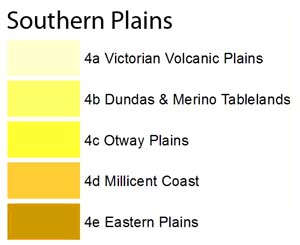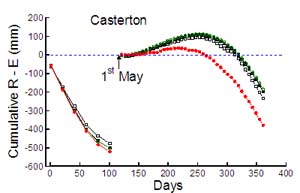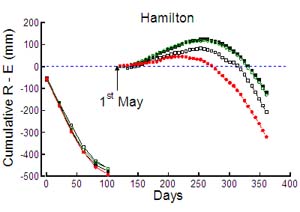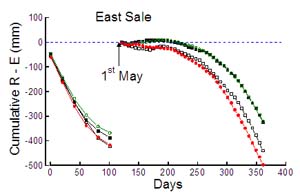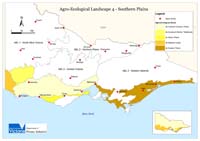Primary Production Landscapes Home | Southern Plains Home
Land use
Covering 51 local government areas and 6 catchment management authority regions, the major land use of the Southern Plains is production from dryland agriculture cropping, grazing and dairy) and forestry (77%). New blue gum forestry plantings are estimated to be 10,000 – 14,000 hectares per year. This has moderated since 8-10 years ago. Irrigated agriculture (8%) and intensive uses including horticulture and animal production (36% of Victoria’s land use) occur also. Rainfall varies from 450 mm west of Melbourne to 1100 mm at the foothills of the Southern Uplands. | |
Primary Production Landscapes
Victorian Volcanic Plains
Volcanic cones, lava flows and ash deposits are used mainly for grazing and cropping. Rainfall is higher and evaporation less than plains north of the divide.
Dundas & Merino Tablelands
The deeply dissected and weathered terrain has traditionally been used for grazing. Constraints to plant growth include soils with low pH and iron gravels that limit access to soil moisture.
Otway Plains
Rainfall within the plains is quite variable and the terrain diverse. Waterlogging is a major production constraint for prominent land uses including dairy and forestry.
Millicent Coast
Siliceous and calcareous plains and dunes are mainly used for dairy, forestry and fodder production. Soils and landforms continue into South Australia where viticulture also occurs.
Eastern Plains
Extensive alluvial systems from erosion of the Eastern Uplands generally receive higher rainfall and less evaporation than plains in the west. Grazing, forestry and dairy are main land uses on gradational and texture contrast soils. | |
Management practices and issues in response to Climate Change
- Many farmers have altered their management practices to include grains and cropping in farming practices.
- Prime lamb production in the Dundas Tablelands is considered a marginal land use and appears more favourable north and south of this area.
- Lambing has shifted to mid-late winter due to a shortage in pasture supply through autumn.
- Changes in animal systems have occurred to reduce livestock stress from feed shortages through the winter. Poorly fed sheep still have disease issues.
- Survival rates for lambing have improved due to warmer winters.
- Timing of rainfall events is critical in grazing systems (rainfall in November 2007 saved the year where hay was produced).
- Sourcing grain for livestock consumption is getting harder. Increases in grain prices have made it nearly prohibitive for livestock consumption.
- Climate has gone from too-wet to too-dry, reducing waterlogging and making trafficking of land much easier than in the past.
- Native trees in improved pastures are dying indicating a stressed ecosystem.
- Pasture persistence is a major issue with less soil moisture available and continued dry seasons.
- Fuel prices are a major concern, limiting travel to major towns (e.g. Hamilton) and reducing social interaction. Fertiliser prices remain an issue.
- Labour (fewer shearers) and contractor shortages with equipment to fit smaller traditional farm holdings are making prime lamb and wool production hard work.
- Off-farm income is required to supplement on-farm income.
- Pressure from forestry for land resources continues. MIS and tax incentives remain an issue to producers.
- Foot rot is no longer such an issue in livestock production systems due to drier soils.
- Worms affecting livestock are less of a problem in grazing through drier summers that result in worm death and clean paddocks.
- Shift away from rye grass pasture base systems due to resistance issues, and use of hardier species including fescue and phalaris in response to drier seasons.
| |
Future scenarios for farming systems
- Grazing systems are struggling to remain competitive with other industries due to climate change and increases in grain prices (feed-lotting hasn’t increased as a result).
- There is expected to be continued significant land use change with a decrease in grazing in favour of cropping and forestry.
- Corporate farming and MIS for cropping will favour bigger operators that potentially don’t face the risks of current farming systems.
- Will different systems evolve with climate? Currently livestock numbers haven’t decreased but stocking rates have increased.
Victoria’s changing climate
Mean annual temperature (two scenarios from past records and one predicted scenario)
1970-1995 | 1996-2005 | 2050 A1FI prediction |
| | |
|
1970-1995 | 1996-2005 | 2050 A1FI prediction |
| | |
|
